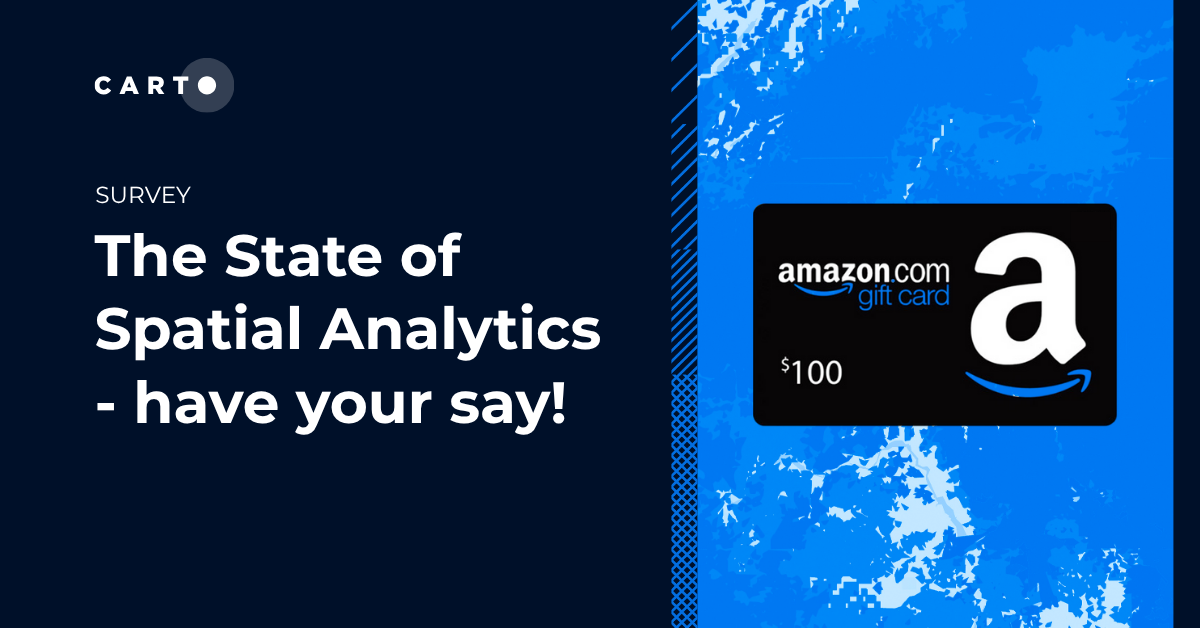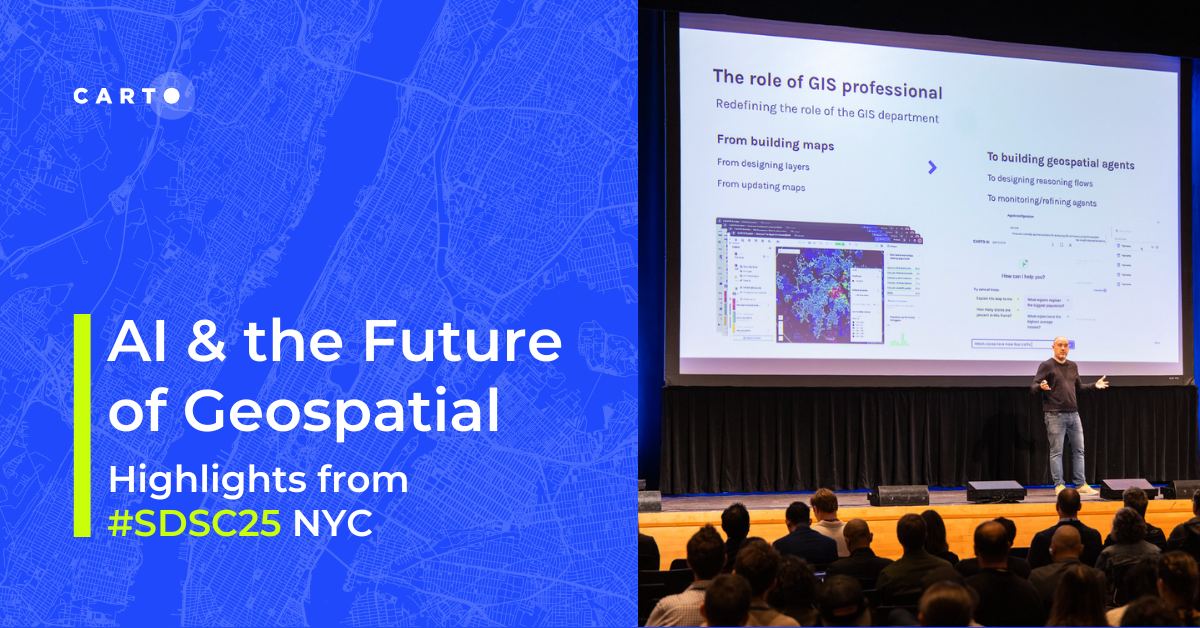What's New in CARTO - Q2 2024

As we transition from one quarter to the next, it’s time for us to recap and share with you some of the exciting new enhancements we have released in the CARTO Platform during the last few months.
Our teams continue to work tirelessly on building the most powerful spatial analytics platform native to the modern data stack, supercharging users of the leading cloud data warehouses with unique geospatial analysis and visualization capabilities.
In addition to the exciting ongoing developments in our platform, one of the highlights of this past quarter was the latest installment of the Spatial Data Science Conference in London. More than 600 attendees from over 200 companies gathered to discuss the present and future of spatial analytics. In our opening keynote, CARTO presented some of what we’ve been working on to bring our vision of an un-siloed GIS data stack to our users, including:
- GeoAI, introducing the upcoming CARTO AI Agents to enable conversational analytics on maps.
- Raster in geoparquet in the leading cloud platforms.
- Our new version of the Analytics Toolbox for Databricks.
If you couldn’t attend, you can watch all of the talks on demand - including our keynote - here, and don’t miss out on the upcoming conference in New York in October!.
Another highlight of this “events season” was CARTO winning the Telecom Data Cloud Partner of the Year award at the Snowflake AI Data Cloud Summit! At the Summit, we also presented the availability of the full CARTO Platform in beta as a Snowflake Native App integrated with Snowpark Container Services, providing users with a seamless integration with Snowflake with optimized performance and more robust security.
Now, let’s take a look at the most recent developments in the CARTO Platform! And remember to regularly check our What’s New page to keep up to date with our product releases.
Helps you to… visualize spatial trends and patterns at an enormous scale in a way that can be quickly and intuitively understood by your users.
Last month we were thrilled to announce the availability of density heatmap visualizations for very large point-based datasets in CARTO. This new feature allows users to render massive amounts of point data as a heatmap in a highly scalable and performant manner, natively from their cloud data warehouse thanks to our dynamic tiling technology. Now available in Builder, users can easily identify hotspot patterns and gain insights from their data at scale.
Developers can also build their own large-scale heatmaps in their spatial apps using the CARTO module in deck.gl, with the new heatmapTileLayer.
Check out this blog for tips, tricks and tutorials for crafting stunning heatmaps!
Helps you to… provide the perfect spatial context for your data and visually align your maps with your brand and other applications.
We know that a basemap is a crucial component of any map, providing essential context, spatial features, and the visual foundation for all your creations. To meet the unique needs of each organization, we now enable you to bring your own basemap directly into your CARTO organization. Admin users can upload custom basemaps and tailor the basemap gallery options available to Editor users in Builder. Unleash your creativity and enjoy an enhanced map-making experience while maintaining a cohesive and consistent selection of basemaps throughout your organization!
Learn more in our documentation and check out our new tutorial in the CARTO Academy for a step-by-step guide.
Helps you to… save, share and disseminate the results of your analysis offline.
This quarter we’ve also launched a new feature that allows users to generate and download detailed PDF reports out of their Builder maps. These reports capture everything from the current map extent to widgets, parameters, and the map description. Whether you're sharing insights with colleagues, presenting to stakeholders, or documenting your analysis, this new feature packs the richness of your interactive maps into a portable, easy-to-share format.
Helps you to... enrich your workflows from data from external API services or integrate your workflows with external services to make automation and integration even more seamless.
We are working towards establishing CARTO Workflows as the best tool for our customers’ spatial data processing and analytical needs, and for that we know that its extensibility is going to play a crucial role. This quarter we announced the ability for users to connect workflows with external API services. With this new capability, you will be able to:
- Retrieve data from external API services: Augment your workflows by importing information from APIs such as Google Environment APIs, government, cadaster, parcel data, and other specialized data sources.
- Trigger actions via API: Automatically trigger external processes, send notifications, or execute commands directly from your workflows, such as notifications in chat applications, integrations with automation tools, etc.
- Send data from your workflows to external APIs: Use data from any node in your workflow to build the body for a request.
Leverage this new feature by using the new HTTP Request component, a dedicated component that facilitates making requests to external APIs, providing enhanced versatility and extensibility. This component also supports custom expressions and variables to embed logic directly into component settings using SQL operators combined with variable and column values.
Helps you to… bring your raster data to the cloud, allowing you to analyze all of your spatial data at scale from one unified workspace.
In our ongoing effort to provide support for cloud-optimized raster data across all platform components, last quarter we were happy to introduce a suite of powerful new features that are set to enable the analysis of raster data in CARTO Workflows. Whether you're looking to extract raster values or perform complex intersect and aggregate operations, our new components - including "Get Raster Values" and "Intersect and Aggregate Raster" - provide you with the tools you need to unlock valuable insights from your raster datasets.
Additionally, users can finally say goodbye to cumbersome raster data ingestion processes. With our latest enhancements, you can effortlessly import your Cloud Optimized GeoTIFFs to Snowflake and BigQuery via both CARTO’s Import API and the Workspace UI. This provides a streamlined and efficient method for ingesting raster files into BigQuery and Snowflake, ensuring optimal storage efficiency and fast query access.
Helps you to… perform advanced spatial data science techniques natively in BigQuery for more robust decision making for telco use cases.
Geospatial analytics at scale is incredibly important for telecom operators, and CARTO is determined to provide telcos with a modern and cloud-native platform that can solve their spatial needs without limitations. This quarter we’re thrilled to announce our new functions for line of sight and signal propagation analysis in the Analytics Toolbox for BigQuery.
These new procedures - available in the telco module - enable network planners to run coverage analysis natively within BigQuery. With our Path Profile and Path Loss functions (supporting now Close In and Extended Hata models), users can now assess the geographical areas where the current or potential new network's signal is available, as well as evaluate its quality.
Learn more in our documentation and follow our step-by-step tutorial.
Additionally, in the Analytics Toolbox for BigQuery, we have also released two new space-time analyses available in the statistics module:
- Space-time hotspot classification, to classify hotspots based on changes in their intensity over time, such as strengthening hotspots, declining hotspots, occasional hotspots, etc. Learn how to with our new tutorial.
- Time-series clustering, to identify locations with similar temporal behaviors. Learn how to with our new tutorial.
Helps you to… easily draw on a huge range of demographic, environmental and economic variables - anywhere in the world!
In May, we announced the release of the third version of our derived data product, CARTO Spatial Features. This dataset provides variables across a wide range of themes including demographics, point of interest, urbanity levels, and climatology with highly granular and global coverage (freely available for the USA, UK & Spain!). In this new version we added new features that model human activity, night light intensity and the presence of telecommunications infrastructure.
Helps you to… keep your maps and workflows organized and easy to find thanks to our tag system
We have introduced a new system that allows users to classify and filter maps and workflows in the CARTO Workspace with tags. With this new feature, editor users will be able to create, apply and filter maps and workflows by tags, considerably improving the organization of assets within CARTO.
Helps you to… effectively utilize and streamline your app development processes
We believe that all paths to success start from the CARTO Workspace, and the path to successfully developing powerful geospatial apps shouldn’t be an exception. With this in mind, we've carefully redesigned the experience when accessing the Developers section, and these are the highlights: new Overview section with a curated list of documentation, guides and examples, a simplified Credentials system to manage all your authentication methods, and a new list containing all your API-enabled Workflows, for easy access.

We are really excited by this wave of new enhancements and features, which we hope you will find valuable for getting the most out of your spatial data. To stay up to date on our most recent product releases remember to regularly check our What’s New page, and follow us on LinkedIn for announcements!
If you are looking for help to get started with your spatial analysis in CARTO, our Academy is full of useful resources for you.















.png)
